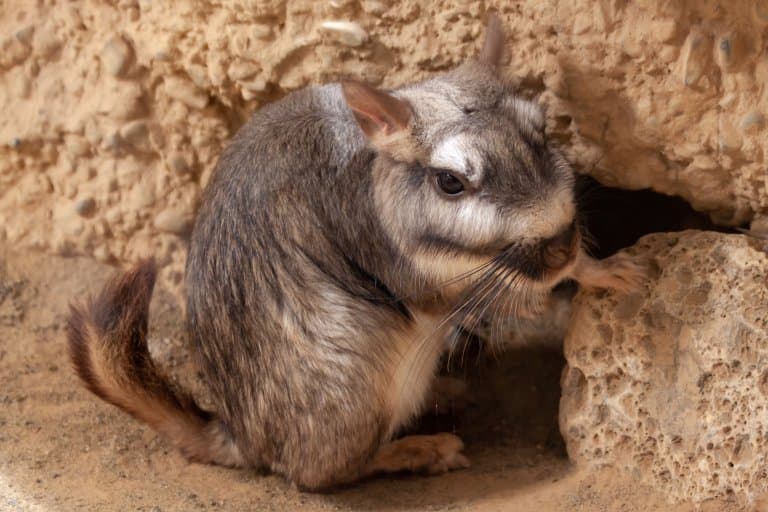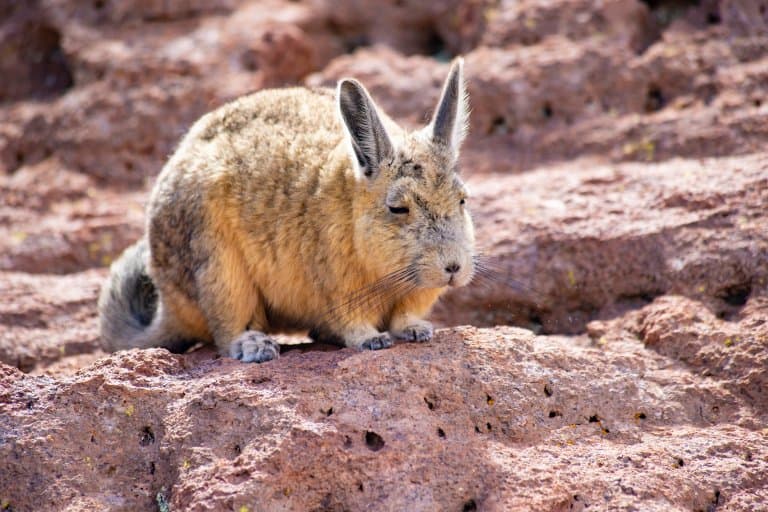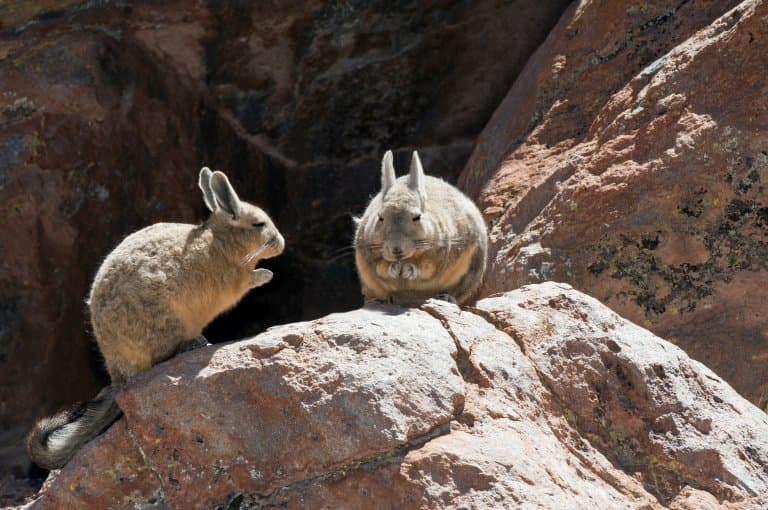Viscacha Profile
In South America, the land of the chinchilla, there’s a very cute and fluffy relative that’s been making the rounds online after one was seen looking a bit tired.
This meme alerted the world to the existence of the Viscacha, a generalist herbivore that takes two main forms, and they’re both adorable.

Viscacha Facts Overview
| Habitat: | Mountainous rocky outcrops and Lowland forest, desert and scrub |
| Location: | South America, Andes |
| Lifespan: | 19 in captivity, around 3 in the wild |
| Size: | Up to 66cm (26 inches) long |
| Weight: | Up to 9kg (20lb) |
| Colour: | Grey to creamy brown |
| Diet: | Grasses and herbs |
| Predators: | Grison, cats |
| Top Speed: | Unknown |
| No. of Species: | 5 |
| Conservation Status: | Least Concern (IUCN) |
The Viscacha is actually two animals, and despite one of them looking a lot like a rabbit, they’re both rodents. The meme-version lives in the mountains and the other species live on the plains, both in South America.
They forage in large groups, never far from their subterranean lounges, into which they’ll quickly dive at the first sign of a threat.
These groups are egalitarian and peaceful, which makes these fluffy little rodents even cuter.
While they’ve been hunted by humans for their fur and meat, they seem to be a resilient group of mammals and their populations are listed as Least Concern in all species.
Interesting Viscacha Facts
1. There are two to choose from
Viscachas occupy two genera in the chinchilla family. The Southern Mountain, or Southern Viscacha lives on the Western side of South America, and the Plains Viscacha is more Centrally located on the continent.
The former is any of four species of mountain specialist, and the latter is a single species of high plains and desert rodents.
Both seem to be doing okay in terms of their populations, but much less is understood about the Plains Viscacha.
The Plains Vischaha is the larger of the two and looks like a bearded chinchilla wearing a covid mask.

The Southern Vischaha, on the other hand, looks the way a Japanese cartoon animator would draw a rabbit.

2. They’re very social
Plains Viscachas occupy large burrows with their social group, and while males will come and go between groups, the females will form loyal bands of foragers who seem to live in an equitable social set-up.
There’s no obvious dominance hierarchy, and they all just hang out, happily grooming one another, making their community one of the most peaceful and utopic among mammals.
Females will stay in these groups their entire lives, and to maintain genetic diversity, males will take up residency for one year, before moving onto another community. Even between groups, agonistic behaviours are uncommon.
Viscahchas are just chill like that. 1
3. They eat their own poop when nobody is looking
This might sound strange, but it’s a very socially-acceptable act in the herbivore world. Fibrous plants hold onto their nutrients very well, and animals with only one stomach struggle to digest them in the first round.
One way to get more out of your food is to pass it through for a second round of digestion, and thus, poop-eating, or “coprophagy” is relatively common.
What’s strange about Plains Viscachas is that when studied to see if they’re one of the species that does this, they seemed to only take part when they were unaware of the researcher’s presence. 2

4. The males are seasonal
Unlike in a lot of rodents, male Viscachas are seasonal breeders. This means they have a certain amount of “testicular regression” during the downtime, only reaching fertility when it’s seasonally convenient to rear young.
This cycle is usually regulated by the length of days, and can go either way: long-day breeders become fertile as the days get longer, and short-day breeders mate when it starts to get dark again. This usually depends on the length of gestation and is timed to produce young during periods of lots of food and warmth.
In Viscachas, the males have the highest rates of sperm production around Summer and Autumn, making them short-day breeders. As the days get shorter, melatonin increases, which triggers the hypothalamus to stimulate sperm production. 3
5. They’re highly precocious when born
If you ever heard this word in a Mary Poppins song, you might think it was gibberish, but it’s used to define a high level of ability at an early age.
In animals who breed so late in the season, it’s important that their young are up and about as quickly as possible, and in the Viscacha, they are some of the most precocious!
Viscachas gestate for around 130 to 150 days, and the young pop out ready for action.
Within hours of being born, they’re already supplementing their milk diet with solid food. They’re born with their eyes open and covered in fur.
This very short preparatory period gives them the best chance at survival, as there are usually only two born to a litter at most, and more often just one. Meanwhile, predators like the Andean Mountain Cat will gladly swallow one if given the chance
Contrast this with humans, who are still rather parasitic and dependent for years, sometimes decades, and may never even grow a full coat of fur in some cases.
6. They talk!
All this high society has led to a wide repertoire of calls and vocalisations. All species of Viscaha seem to talk a lot with one another using a range of different chatter.
They also drum on the ground to draw attention to themselves. This form of communication is called seismic signalling. 4

7. They’ve been persecuted
Humans are another predator of the Viscacha. They’re hunted for their fur and as food, but they’ve also been slain in large numbers after being blamed for a plague.
In Argentina, in 1905, there was an outbreak of plague in the nation, for which the Plains Viscacha was blamed. In many areas, the species was eradicated as a result.
However, they’re tenacious little rodents and are surviving well despite increases in cattle grazing threatening their habitats. 5
Viscacha Fact-File Summary
Scientific Classification
| Kingdom: | Animalia |
| Phylum: | Chordata |
| Class: | Mammalia |
| Order: | Rodentia |
| Family: | Chinchillidae |
Fact Sources & References
- Lyn C. Branch (1993), “Social organization and mating system of the plains viscacha (Lagostomus maximus)”, Publication.
- Marcus Clauss (2007), “Demonstrating coprophagy with passage markers? The example of the plains viscacha (Lagostomus maximus)”, Science Direct.
- Estela M. Muñoz (1996), “Stages of the cycle of the seminiferous epithelium of the Viscacha (Lagostomus maximus maximus)”, Wiley Online Library.
- “Chinchillidae”, SMSG.
- “Plains Viscacha”, IUCN.
